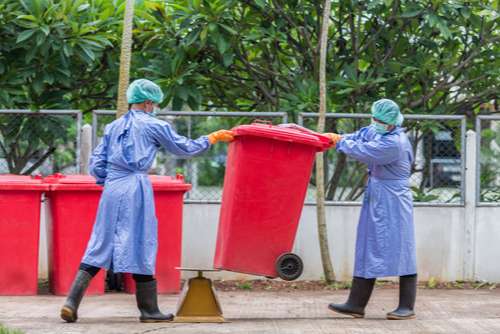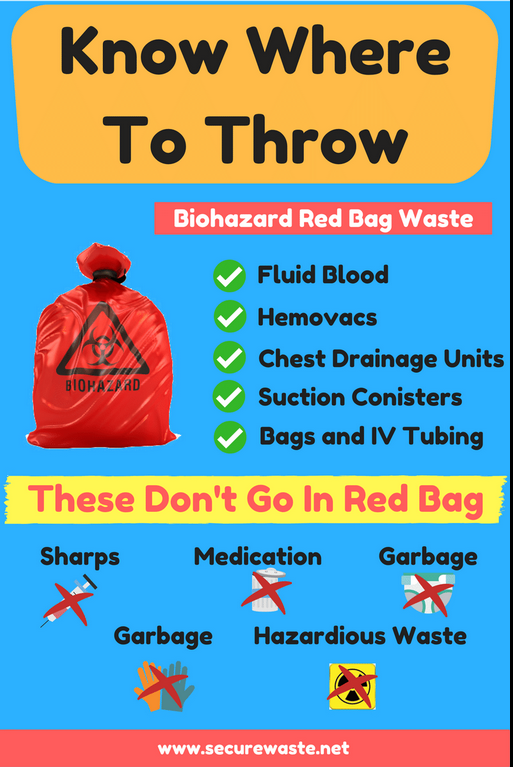Guardians of Cleanliness: Local Medical Waste Removal Service for Your Assurance
Guardians of Cleanliness: Local Medical Waste Removal Service for Your Assurance
Blog Article
Remain Ahead of Rules: Specialist Guidance on Medical Waste Disposal
In a globe where the medical care sector is constantly developing, it is imperative for medical facilities to stay ahead of policies when it pertains to the correct disposal of clinical waste. With rigorous standards and frequent regulatory changes, it can be challenging to navigate the complexities of this process. With professional guidance, facilities can guarantee compliance and mitigate risks linked with inappropriate waste disposal. From recognizing the various groups of clinical waste to carrying out the appropriate collection and partition techniques, this discussion will give valuable understandings and workable suggestions to assist facilities remain in advance of policies in the ever-changing landscape of medical garbage disposal.
Comprehending Clinical Waste Categories
Understanding clinical waste categories is crucial for appropriate disposal and management in health care centers. Medical waste describes any waste created by healthcare tasks that might position a hazard to public health or the atmosphere. It is crucial to categorize clinical waste accurately to ensure its secure handling, therapy, disposal, and transportation.
There are numerous groups of medical waste that health care centers require to be acquainted with. The most typical groups consist of infectious waste, pathological waste, sharps waste, pharmaceutical waste, and chemical waste. Each classification has certain standards and laws for its proper administration and disposal.
Pathological waste refers to human tissues, organs, or body parts that call for unique handling and disposal. Drug waste makes up expired, unused, or infected medicines that require cautious handling and disposal.
Staying Up-To-Date With Regulatory Changes
Remaining existing with regulative modifications is vital for health care facilities to ensure conformity and appropriate administration of medical garbage disposal. medical waste removal service. With regulations constantly advancing, it is necessary for health care facilities to remain updated to avoid fines, fines, and potential damage to the environment and public health
To remain ahead of governing modifications, healthcare centers ought to develop a system for tracking and monitoring updates. This can be done by signing up for regulatory e-newsletters, attending meetings and workshops, and proactively taking part in sector associations. In addition, facilities must designate a team member or group in charge of staying notified and distributing info to relevant stakeholders.
Normal communication with governing firms is also essential. Medical care centers need to develop relationships with local, state, and federal agencies to guarantee they are aware of any adjustments in guidelines that may influence their waste monitoring methods. This can be done through normal meetings, involvement in public comment durations, and aggressive interaction with regulative agencies.
Additionally, health care centers must take into consideration partnering with waste monitoring companies that focus on medical waste disposal (medical waste disposal services with WasteX). These firms are usually skilled in the most up to date laws and can supply advice and support to ensure conformity
Carrying Out Appropriate Collection and Segregation Methods
To effectively manage medical garbage disposal, healthcare facilities should develop proper collection and segregation techniques in accordance with governing standards. Carrying out these methods guarantees the risk-free handling and disposal of possibly hazardous materials, shields the environment, and reduces the danger of injuries and infections to healthcare workers and the public.
Correct collection and segregation methods entail the usage of assigned containers and identifying systems. Health care facilities must supply plainly labeled containers for various kinds of medical waste, such as sharps, contagious waste, pharmaceutical waste, and non-hazardous waste. These containers ought to be color-coded and plainly significant to avoid confusion and promote easy recognition.
Additionally, medical care facilities must train their personnel on the appropriate treatments for collecting and setting apart medical waste. This consists of educating them on the different sorts of waste, the proper containers to make use of, and the value of complying with policies and standards. Normal training sessions and refresher training courses ought to be conducted to make certain that team member remain current on ideal methods.
Moreover, healthcare facilities need to develop a system for normal collection and disposal of medical waste. This might include partnering with accredited waste management companies that concentrate on medical waste disposal. These firms will ensure that the gathered waste is carried and disposed of in conformity with governing requirements.
Selecting the Right Disposal Approaches

Incineration is among the most typical and efficient approaches for dealing with specific kinds of medical waste, such as pathological waste and sharps. It includes the controlled combustion of waste at heats, minimizing it to ash. Incineration can release hazardous contaminants into the air and contribute to air contamination.

Other disposal methods include chemical treatment, microwave treatment, and landfilling. Chemical therapy entails making use of chemicals to neutralize the waste and decontaminate. Microwave therapy uses microwave power to heat and decontaminate the waste. Landfilling includes burying the waste in a marked landfill location (medical waste disposal services with WasteX). Nevertheless, landfilling must be the click here for more last option due to the potential risk of contamination to soil and groundwater.
Guaranteeing Compliance With Paperwork and Training
After very carefully taking into consideration the proper disposal approaches for clinical waste, health care facilities should guarantee compliance with regulations and minimize environmental influence by applying reliable documents and training procedures. This step is essential in maintaining a safe and lasting environment for both healthcare employees and the basic public.

Healthcare employees that take care of clinical waste should obtain ideal training on waste partition, taking care of, and disposal treatments. By giving thorough training, medical care centers can encourage their personnel to make educated decisions and reduce the risk of visit this site improper waste disposal.
Conclusion
In conclusion, staying ahead of regulations in medical garbage disposal is critical for medical care centers. medical waste removal services. Comprehending the different categories of medical waste, remaining upgraded with regulative changes, executing proper collection and partition techniques, selecting the suitable disposal techniques, and guaranteeing compliance via documents and training are all important steps. By complying with these standards, health care organizations can effectively dispose and handle of medical waste in a liable and risk-free fashion
From comprehending the different categories of medical waste to implementing the ideal collection and segregation techniques, this discussion will certainly provide useful insights and workable tips to help facilities remain ahead of guidelines in the ever-changing landscape of medical waste disposal. - medical waste disposal services with WasteX
The most usual groups consist of infectious waste, pathological waste, sharps waste, pharmaceutical waste, and chemical waste. Healthcare facilities ought to offer clearly identified containers for different types of medical waste, such as sharps, contagious waste, pharmaceutical waste, and non-hazardous waste. Health care facilities ought to establish an extensive system to tape and track all elements of clinical waste disposal, including types of waste generated, quantities, and disposal methods used. Healthcare employees that manage clinical waste must get suitable training on waste segregation, handling, and disposal treatments.
Report this page